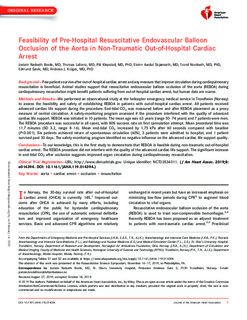| dc.contributor.author | Brede, Jostein Rødseth | |
| dc.contributor.author | Lafrenz, Thomas | |
| dc.contributor.author | Klepstad, Pål | |
| dc.contributor.author | Skjærseth, Eivinn Årdal | |
| dc.contributor.author | Nordseth, Trond | |
| dc.contributor.author | Søvik, Edmund | |
| dc.contributor.author | Krüger, Andreas | |
| dc.date.accessioned | 2020-02-19T08:29:05Z | |
| dc.date.available | 2020-02-19T08:29:05Z | |
| dc.date.created | 2019-11-17T13:13:01Z | |
| dc.date.issued | 2019 | |
| dc.identifier.issn | 2047-9980 | |
| dc.identifier.uri | http://hdl.handle.net/11250/2642452 | |
| dc.description.abstract | Background
Few patients survive after out‐of‐hospital cardiac arrest and any measure that improve circulation during cardiopulmonary resuscitation is beneficial. Animal studies support that resuscitative endovascular balloon occlusion of the aorta (REBOA) during cardiopulmonary resuscitation might benefit patients suffering from out‐of‐hospital cardiac arrest, but human data are scarce.
Methods and Results
We performed an observational study at the helicopter emergency medical service in Trondheim (Norway) to assess the feasibility and safety of establishing REBOA in patients with out‐of‐hospital cardiac arrest. All patients received advanced cardiac life support during the procedure. End‐tidal CO2 was measured before and after REBOA placement as a proxy measure of central circulation. A safety‐monitoring program assessed if the procedure interfered with the quality of advanced cardiac life support. REBOA was initiated in 10 patients. The mean age was 63 years (range 50–74 years) and 7 patients were men. The REBOA procedure was successful in all cases, with 80% success rate on first cannulation attempt. Mean procedural time was 11.7 minutes (SD 3.2, range 8–16). Mean end‐tidal CO2 increased by 1.75 kPa after 60 seconds compared with baseline (P<0.001). Six patients achieved return of spontaneous circulation (60%), 3 patients were admitted to hospital, and 1 patient survived past 30 days. The safety‐monitoring program identified no negative influence on the advanced cardiac life support quality.
Conclusions
To our knowledge, this is the first study to demonstrate that REBOA is feasible during non‐traumatic out‐of‐hospital cardiac arrest. The REBOA procedure did not interfere with the quality of the advanced cardiac life support. The significant increase in end‐tidal CO2 after occlusion suggests improved organ circulation during cardiopulmonary resuscitation. | nb_NO |
| dc.language.iso | eng | nb_NO |
| dc.publisher | Wiley and American Heart Association | nb_NO |
| dc.rights | Attribution-NonCommercial-NoDerivatives 4.0 Internasjonal | * |
| dc.rights.uri | http://creativecommons.org/licenses/by-nc-nd/4.0/deed.no | * |
| dc.title | Feasibility of Pre-Hospital Resuscitative Endovascular Balloon Occlusion of the Aorta in Non-Traumatic Out-of-Hospital Cardiac Arrest | nb_NO |
| dc.type | Journal article | nb_NO |
| dc.type | Peer reviewed | nb_NO |
| dc.description.version | publishedVersion | nb_NO |
| dc.source.volume | 8 | nb_NO |
| dc.source.journal | Journal of the American Heart Association | nb_NO |
| dc.source.issue | 22 | nb_NO |
| dc.identifier.doi | 10.1161/JAHA.119.014394 | |
| dc.identifier.cristin | 1748376 | |
| dc.description.localcode | Copyright © 2019 The Authors. Published on behalf of the American Heart Association, Inc., by Wiley Blackwell This is an open access article under the terms of the Creative Commons Attribution‐NonCommercial‐NoDerivs License, which permits use and distribution in any medium, provided the original work is properly cited, the use is non‐commercial and no modifications or adaptations are made. | nb_NO |
| cristin.unitcode | 1920,29,0,0 | |
| cristin.unitcode | 1920,28,0,0 | |
| cristin.unitcode | 194,65,25,0 | |
| cristin.unitcode | 1920,4,0,0 | |
| cristin.unitname | Klinikk for akutt- og mottaksmedisin | |
| cristin.unitname | Klinikk for anestesi og intensivmedisin | |
| cristin.unitname | Institutt for sirkulasjon og bildediagnostikk | |
| cristin.unitname | Klinikk for bildediagnostikk | |
| cristin.ispublished | true | |
| cristin.fulltext | original | |
| cristin.qualitycode | 1 | |

